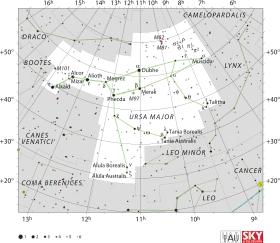Pi1 Ursae Majoris
Pi1 Ursae Majoris (π1 Ursae Majoris / π1 UMa) est une naine jaune de la constellation de la Grande Ourse. De magnitude apparente moyenne de 5,63, elle est située à environ 46,8 années-lumière de la Terre[1] et est relativement jeune (environ 200 millions d'années)[10]. C'est une étoile variable de type BY Draconis ; l'amplitude de variation de sa luminosité est de 0,08 magnitude. La première éruption en rayons X d'une étoile de type solaire a été observée sur Pi1 Ursae Majoris en 1986[12]. Cette étoile fait partie du courant d'étoiles de la Grande Ourse, un ensemble d'étoiles qui se déplacent de la même façon à travers l'espace, et qui comprend notamment cinq des sept étoiles de l'astérisme de la Grande Casserole[8] - [13].
| Ascension droite | 08h 39m 11,70440s[1] |
|---|---|
| Déclinaison | +65° 01′ 15,2667″[1] |
| Constellation | Grande Ourse |
| Magnitude apparente | 5,63 |
Localisation dans la constellation : Grande Ourse  | |
| Type spectral | G1.5Vb[2] |
|---|---|
| Indice U-B | +0,07[3] |
| Indice B-V | +0,62[3] |
| Variabilité | BY Draconis |
| Vitesse radiale | –13,88 ± 0,47 km/s[4] |
|---|---|
| Mouvement propre |
μα = −27,44 ± 0,31 mas/a[1] μδ = +88,13 ± 0,26 mas/a[1] |
| Parallaxe | 69,66 ± 0,37 mas |
| Magnitude absolue | 4,86[5] |
| Masse | 0,90 M☉[6] |
|---|---|
| Gravité de surface (log g) | 4,48[7] |
| Luminosité | 0,97 L☉[8] |
| Température | 5 884 ± 6,8 K[9] |
| Âge | 200 × 106 a[10] |
Autres désignations
π1 UMa, 3 UMa (Flamsteed), GJ 311, HR 3391, HD 72905, SAO 14609, BD+65°643, HIP 42438[11]
Un excès de rayonnement infrarouge en provenance de Pi1 Ursae Majoris a été détecté, ce qui y suggère la présence d'un disque de débris. L'ajustement de modèles aux données semblent indiquer qu'il y a un anneau de débris fins à un rayon d'environ 0,4 UA composé de grains de silicates ou des cristaux de forstérite de 0,25 µm. Il peut également s'agir d'un plus large cercle de grains plus épais (10 µm) à une distance qui pourrait aller jusqu'à 16 UA[14].
Références
- (en) Floor van Leeuwen, Hipparcos, the new Reduction of the Raw data, vol. 350, Springer, coll. « Astrophysics and Space Science Library », , 449 p. (ISBN 978-1-4020-6341-1, DOI 10.1051/0004-6361:20078357, Bibcode 2007A&A...474..653V, arXiv 0708.1752, lire en ligne) Note: see VizieR catalogue I/311.
- D. Montes, J. López-Santiago, M. C. Gálvez, M. J. Fernández-Figueroa, E. De Castro et M. Cornide, « Late-type members of young stellar kinematic groups - I. Single stars », Monthly Notices of the Royal Astronomical Society, vol. 328, no 1, , p. 45–63 (DOI 10.1046/j.1365-8711.2001.04781.x, Bibcode 2001MNRAS.328...45M, arXiv astro-ph/0106537)
- H. L. Johnson, B. Iriarte, R. I. Mitchell et W. Z. Wisniewskj, « UBVRIJKL photometry of the bright stars », Communications of the Lunar and Planetary Laboratory, vol. 4, no 99, (Bibcode 1966CoLPL...4...99J)
- Russel J. White, Jared M. Gabor et Lynne A. Hillenbrand, « High-Dispersion Optical Spectra of Nearby Stars Younger Than the Sun », The Astronomical Journal, vol. 133, no 6, , p. 2524–2536 (DOI 10.1086/514336, Bibcode 2007AJ....133.2524W, arXiv 0706.0542)
- J. Holmberg, B. Nordström et J. Andersen, « The Geneva-Copenhagen survey of the solar neighbourhood. III. Improved distances, ages, and kinematics », Astronomy and Astrophysics, vol. 501, no 3, , p. 941–947 (DOI 10.1051/0004-6361/200811191, Bibcode 2009A&A...501..941H, arXiv 0811.3982)
- Ed J. Shaya et Rob P. Olling, « Very Wide Binaries and Other Comoving Stellar Companions: A Bayesian Analysis of the Hipparcos Catalogue », The Astrophysical Journal Supplement, vol. 192, no 1, , p. 2 (DOI 10.1088/0067-0049/192/1/2, Bibcode 2011ApJS..192....2S, arXiv 1007.0425)
- A. J. Cenarro, R. F. Peletier, P. Sánchez-Blázquez, S. O. Selam, E. Toloba, N. Cardiel, J. Falcón-Barroso, Gorgas J. et J. Jiménez-Vicente, « Medium-resolution Isaac Newton Telescope library of empirical spectra - II. The stellar atmospheric parameters », Monthly Notices of the Royal Astronomical Society, vol. 374, no 2, , p. 664–690 (DOI 10.1111/j.1365-2966.2006.11196.x, Bibcode 2007MNRAS.374..664C, arXiv astro-ph/0611618)
- E. J. Gaidos, G. W. Henry et S. M. Henry, « Spectroscopy and Photometry of Nearby Young Solar Analogs », The Astronomical Journal, vol. 120, no 2, , p. 1006–1013 (DOI 10.1086/301488, Bibcode 2000AJ....120.1006G)
- V. V. Kovtyukh, C. Soubiran, S. I. Belik et N. I. Gorlova, « High precision effective temperatures for 181 F-K dwarfs from line-depth ratios », Astronomy and Astrophysics, vol. 411, no 3, , p. 559–564 (DOI 10.1051/0004-6361:20031378, Bibcode 2003A&A...411..559K, arXiv astro-ph/0308429)
- Eric E. Mamajek et Lynne A. Hillenbrand, « Improved Age Estimation for Solar-Type Dwarfs Using Activity-Rotation Diagnostics », The Astrophysical Journal, vol. 687, no 2, , p. 1264–1293 (DOI 10.1086/591785, Bibcode 2008ApJ...687.1264M, arXiv 0807.1686)
- (en) * pi.01 UMa -- Variable of BY Dra type sur la base de données Simbad du Centre de données astronomiques de Strasbourg.
- M. Landini, B. C. Monsignori Fossi, R. Pallavicini et L. Piro, « EXOSAT detection of an X-ray flare from the solar type star Pi-prime UMa », Astronomy and Astrophysics, vol. 157, no 2, , p. 217–222 (Bibcode 1986A&A...157..217L)
- J. Maldonado, R. M. Martínez-Arnáiz, C. Eiroa, D. Montes et B. Montesinos, « A spectroscopy study of nearby late-type stars, possible members of stellar kinematic groups », Astronomy and Astrophysics, vol. 521, , A12 (DOI 10.1051/0004-6361/201014948, Bibcode 2010A&A...521A..12M, arXiv 1007.1132)
- C. A. Beichman, A. Tanner, G. Bryden, K. R. Stapelfeldt, M. W. Werner, G. H. Rieke, D. E. Trilling, S. Lawler et T. N. Gautier, « IRS Spectra of Solar-Type Stars: A Search for Asteroid Belt Analogs », The Astrophysical Journal, vol. 639, no 2, , p. 1166–1176 (DOI 10.1086/499424, Bibcode 2006ApJ...639.1166B, arXiv astro-ph/0601467)
Lien externe
- (en) Pi1 Ursae Majoris sur la base de données Simbad du Centre de données astronomiques de Strasbourg.